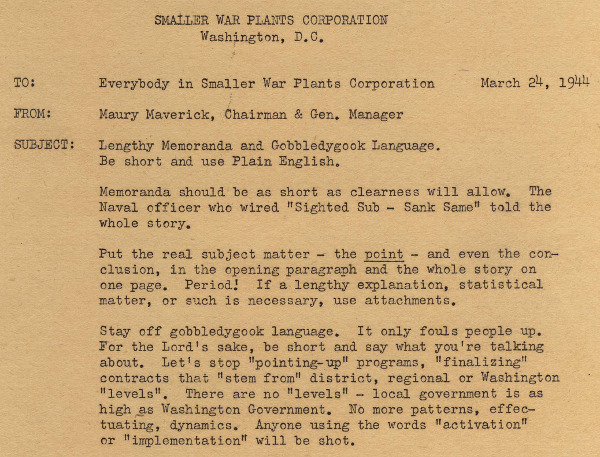In 1944, manager Maury Maverick sent this memo to the workers at his government agency:

This is the first known usage of gobbledygook to refer to obscure jargon. It wouldn’t be the last.
(From the National Archives.)
In 1944, manager Maury Maverick sent this memo to the workers at his government agency:

This is the first known usage of gobbledygook to refer to obscure jargon. It wouldn’t be the last.
(From the National Archives.)

A poem written by Amelia Earhart in 1928:
Courage is the price that
Life exacts for granting peace.
The soul that knows it not, knows no release
From little things:
Knows not the livid loneliness of fear,
Nor mountain heights where bitter joy can hear
The sound of wings.
How can life grant us boon of living, compensate
For dull grey ugliness and pregnant hate
Unless we dare
The soul’s dominion? Each time we make a choice, we pay
With courage to behold the resistless day,
And count it fair.
“Please know I am quite aware of the hazards,” she wrote in a final letter left to her husband. “I want to do it because I want to do it. Women must try to do things as men have tried. When they fail, their failure must be but a challenge to others.”
The employees of a company are trying to decide whether to give up a pay raise so they can afford to install a workplace safety measure. Each employee will vote for the sacrifice if she thinks the danger is sufficiently serious, if the safety measure is sufficiently effective, and if the pay sacrifice is sufficiently bearable. Otherwise she’ll vote against it. The three employees come to this result:

This is troubling: A majority of employees supports each of the criteria, and yet each of the three resolves to reject the proposal. If the employees reach their decision by comparing their views about the measure as a whole, then they’ll reject the pay sacrifice. But if they compare their views about each criterion, they’ll accept it.
Princeton philosopher Philip Pettit worries that this phenomenon makes it impossible for us to make confident statements about the beliefs of a group. “Going the conclusion-driven way means adopting a course that is inconsistent with the premises endorsed by the group, and going the premise-driven way means adopting a course that a majority individually reject.”
Both outcomes are undesirable. “Going the first way means sacrificing collective rationality for the sake of responsiveness to individuals, going the second means sacrificing responsiveness to individuals for the sake of collective rationality.”
(Philip Pettit, “Deliberative Democracy and the Discursive Dilemma,” Philosophical Issues 11:1 [2001], 268-299.)
From the postscript to a 1737 letter by Jonathan Swift — “Here is a rhyme; it is a satire on an inconstant lover.”
You are as faithless as a Carthaginian,
To love at once Kate, Nell, Doll, Martha, Jenny, Anne.
In 1864 a photographer employed by Mathew Brady used a four-lens camera to record activity at a Union Army wharf along Potomac Creek in Virginia. The four images were taken in quick succession, so staggering them produces a crude time lapse of the events they record:
In effect they present a four-frame film, perhaps the closest we’ll come to a contemporary movie of life during the Civil War. Here are a few more, all taken in Virginia in 1864:
Union cavalry crossing a pontoon bridge over the James River:
Traffic in front of the Marshall House in Alexandria:
Union soldiers working on a bridge over the Pamunkey River near White House Landing:
There’s more information at the National Park Service’s Fredericksburg & Spotsylvania National Military Park blog.

In 1897, confused physician Edward J. Goodwin submitted a bill to the Indiana General Assembly declaring that he’d squared the circle — a mathematical feat that was known to be impossible. In today’s show we’ll examine the Indiana pi bill, its colorful and eccentric sponsor, and its celebrated course through a bewildered legislature and into mathematical history.
We’ll also marvel at the confusion wrought by turkeys and puzzle over a perplexing baseball game.

Twenty-six villages are ranged around the coastline of an island. Their names, in order, are A, B, C, …, Z. At various times in its history, the island has been visited by 26 missionaries, who names are also A, B, C, …, Z. Each missionary landed first at the village that bore his name and began his work there. Each village was pagan to begin with but became converted when visited by a missionary. Whenever a missionary converted a village he would move along the coastline to the next village in the cycle A–B–C-…-Z–A. If a missionary arrived at an uncoverted village he’d convert it and continue along the cycle, but there was never more than one missionary in a village at a time. If a missionary arrived at a village that had already been converted, the villagers, feeling oppressed, would kill him and revert to a state of paganism; they would do this even to a missionary who had converted them himself and then traveled all the way around the island. There’s no restriction as to how many missionaries can be on the island at any given time. After all 26 missionaries have come and gone, how many villages remain converted?
Of course, she’s only a digestive tube, like all of us.
Yes, but look what it’s attached to!
— Gavin Ewart
Today marks the 400th anniversary of William Shakespeare’s death. To commemorate it, Craig Knecht has devised a 44 × 44 magic square (click to enlarge). Like the squares we featured in 2013, this one is topographical — if the number in each cell is taken to represent its altitude, and if water runs “downhill,” then a fall of rain will produce the pools shown in blue, recalling the words of Griffith in Henry VIII:
Noble madam,
Men’s evil manners live in brass; their virtues
We write in water.
The square includes cells (in light blue) that reflect the number of Shakespeare’s plays (38) and sonnets (154) and the year of his death (1616).
(Thanks, Craig.)
In 1956 Macedonian poet Venko Markovski was imprisoned under a fictitious name for circulating a poem critical of Marshal Tito.
Among the guards were individuals who were taking correspondence courses in an attempt to earn a degree. One of these guards, knowing I was a writer, came up to me one day and said: ‘I was told you are a writer. You have knowledge of literature. I have a request …’
‘Please, what do you want to know about literature?’
‘Tell me about Macedonian literature.’
‘Whom are you interested in?’
‘Venko Markovski.’
‘Is it possible you don’t recognize Venko Markovski?’
‘I don’t know him.’
There was an unpleasant pause. I felt sorry for this man who was ordered to guard someone without knowing whom he was guarding. I spoke to him as follows:
‘The best way for you to learn about Venko Markovski is to read his poetry written in Croatian. In this way you will understand Markovski the poet, the Partisan, the public figure, and you will pass your exam easily. But if you rely on me to tell you about Venko Markovski, you will find yourself — after you fail your exam — in the very place where Markovski now finds himself.’
‘What do you mean by that?’ the guard asked. ‘Where is he in fact?’
‘Right in front of you, here on Goli Otok.’
‘Can it be that you are really he?’
‘Yes, I am here under another name.’
The guard walked away silent and confused.
“The warden obviously thought that since he had physical possession of his prisoners he disposed of their minds and souls as well,” Markovski wrote after gaining his freedom in 1961. “But he was mistaken; the body is one thing and the soul is another. There is no way to bribe the human conscience once it has committed itself to the struggle for the rights of its people.”
(From Geoffrey Bould, ed., Conscience Be My Guide: An Anthology of Prison Writings, 2005.)